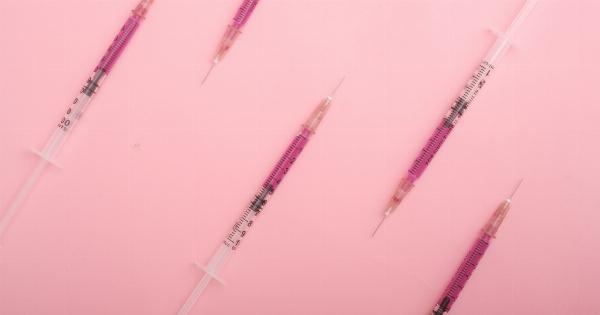Meningitis is a serious medical condition that causes inflammation of the protective membranes (meninges) surrounding the brain and spinal cord. It can be caused by a variety of factors including viruses, bacteria, fungi, or parasites.
Meningitis can result in severe complications and even prove fatal if not diagnosed and treated promptly. Here are 9 essential facts about meningitis that everyone should know:.
1. Types of Meningitis
Meningitis can be classified into several types based on the cause:.
a) Viral Meningitis: This is the most common type of meningitis and is usually caused by non-polio enteroviruses. Most cases of viral meningitis tend to be mild and resolve on their own within a couple of weeks.
b) Bacterial Meningitis: This form of meningitis is caused by several types of bacteria such as Streptococcus pneumoniae, Neisseria meningitidis, and Haemophilus influenzae.
Bacterial meningitis is a medical emergency and requires immediate treatment due to its potential for rapid progression and severe complications.
c) Fungal Meningitis: This type of meningitis is relatively rare and is usually caused by certain fungi found in soil, like Cryptococcus and Histoplasma. Fungal meningitis is often chronic and requires long-term treatment.
d) Parasitic Meningitis: Parasitic meningitis is caused by certain parasites, such as Naegleria fowleri and Angiostrongylus cantonensis.
It is a rare form of meningitis that can be acquired through contact with contaminated water or consuming raw or undercooked snails or slugs.
2. Common Symptoms
The signs and symptoms of meningitis can vary depending on the age of the affected individual and the type of meningitis they have. However, there are some common symptoms that may indicate the presence of meningitis:.
a) High Fever: A sudden and high fever is often one of the initial symptoms of meningitis. The fever may be accompanied by chills or severe sweating.
b) Severe Headache: Meningitis often causes intense headaches that may be persistent or worsen over time.
c) Stiff Neck: Neck stiffness is a classic symptom of meningitis. The person may find it difficult to touch their chin to their chest due to stiffness and pain.
d) Nausea, Vomiting, and Photophobia: Meningitis can cause sensitivity to light (photophobia) along with nausea and vomiting.
e) Altered Mental Status: Confusion, irritability, or a decreased level of consciousness may indicate meningitis.
f) Seizures: In some cases, meningitis can trigger seizures, especially in young children.
g) Skin Rash: Certain types of bacterial meningitis can result in a distinctive skin rash, such as the petechial rash seen in meningococcal meningitis.
h) Poor Feeding (infants) or Loss of Appetite (adults): Infants with meningitis may refuse to eat or have poor feeding habits, while adults may experience a loss of appetite.
3. Transmission
The transmission of meningitis varies depending on the type:.
a) Viral Meningitis: Viral meningitis is typically spread through contact with an infected person’s respiratory secretions, such as by coughing or sneezing.
b) Bacterial Meningitis: Bacterial meningitis can be spread through droplets of respiratory or throat secretions. It commonly occurs among individuals living in close quarters, such as college dormitories or military barracks.
c) Fungal Meningitis: Fungal meningitis is usually acquired by inhaling fungal spores present in the environment.
d) Parasitic Meningitis: Parasitic meningitis is typically acquired through exposure to contaminated water sources or by consuming undercooked snails or slugs.
4. Risk Factors
Several risk factors increase an individual’s vulnerability to meningitis:.
a) Age: Children under the age of 5 and adolescents between 16 and 25 years are at a higher risk of contracting meningitis.
b) Weakened Immune System: Individuals with compromised immune systems, such as those living with HIV/AIDS, undergoing chemotherapy, or taking immunosuppressive medications, are more susceptible to meningitis.
c) Crowded Living Conditions: People living in close quarters or crowded environments are at an increased risk of transmitting bacterial meningitis.
d) Lack of Vaccination: Failing to receive routine vaccinations, such as the meningococcal or pneumococcal vaccines, can increase the risk of bacterial meningitis.
e) Pregnancy: Pregnant women have a slightly higher risk of contracting listeriosis, which can lead to meningitis.
5. Diagnosis
Medical professionals utilize several methods to diagnose meningitis:.
a) Physical Examination: A thorough physical examination is conducted to check for common signs of meningitis, such as neck stiffness and skin rashes.
b) Lumbar Puncture (Spinal Tap): A sample of cerebrospinal fluid (CSF) is extracted through a lumbar puncture to analyze the presence of bacteria, viruses, or fungi that may be causing meningitis.
c) Blood Tests: Blood tests are performed to identify markers of infection and inflammation in the bloodstream.
d) Imaging Tests: Imaging techniques like CT scans or MRI may be used to detect any potential complications, such as brain swelling or abscesses.
6. Treatment
Treatment for meningitis depends on the underlying cause:.
a) Viral Meningitis: Most cases of viral meningitis resolve without specific treatment. Supportive care, such as rest, hydration, and over-the-counter pain relievers to manage symptoms, is generally recommended.
b) Bacterial Meningitis: Bacterial meningitis necessitates immediate hospitalization and treatment with intravenous antibiotics. Prompt treatment is crucial to prevent severe complications and reduce the risk of death.
c) Fungal Meningitis: Fungal meningitis typically requires long-term treatment with antifungal medications, which may be administered orally or intravenously depending on the severity of the infection.
d) Parasitic Meningitis: Treatment for parasitic meningitis varies depending on the parasite causing the infection and may involve antiparasitic medications, supportive care, and management of complications.
7. Prevention
Several preventive measures can help reduce the risk of meningitis:.
a) Vaccination: Routine vaccinations, such as the meningococcal, pneumococcal, and Hib vaccines, can protect against the most common causes of bacterial meningitis.
b) Good Hygiene Practices: Practicing good personal hygiene, such as frequent handwashing, covering your mouth and nose while coughing or sneezing, and avoiding sharing utensils or drinks, can help prevent the spread of viral and bacterial infections.
c) Prophylactic Antibiotics: In situations where there has been close contact with someone diagnosed with bacterial meningitis, a healthcare provider may prescribe prophylactic antibiotics to prevent the infection from developing.
d) Avoiding Exposure: Taking precautions to avoid exposure to environments or substances that may harbor fungal or parasitic pathogens, such as contaminated water or certain animals, can reduce the risk of fungal or parasitic meningitis.
8. Potential Complications
Meningitis can lead to severe complications:.
a) Brain Damage: Inflammation caused by meningitis can potentially result in brain damage, leading to long-term disabilities including cognitive impairment, learning difficulties, seizures, and problems with movement or coordination.
b) Hearing Loss: Meningitis-associated hearing loss can range from mild to profound and may require hearing aids or other interventions.
c) Vision Problems: Some individuals with meningitis may experience vision problems or even blindness.
d) Kidney Failure: In rare cases, severe meningococcal infection can lead to kidney failure.
e) Septicemia: Meningitis caused by certain bacteria, particularly Neisseria meningitidis, can cause septicemia (blood poisoning), a life-threatening condition.
9. Post-Meningitis Aftercare
Recovering from meningitis often requires ongoing care and support:.
a) Follow-Up Appointments: Regular follow-up appointments are necessary to monitor recovery and address any long-term complications or side effects.
b) Cognitive and Physical Rehabilitation: In cases where neurological damage has occurred, cognitive and physical rehabilitation may be required to regain lost abilities and maximize functional recovery.
c) Emotional Support: Meningitis can have long-lasting emotional impacts.
Seeking support from healthcare professionals, support groups, or counseling services can assist individuals and their families in coping with the emotional aftermath.





























